Soup is a beloved comfort food that can vary greatly in terms of its carbohydrate content. Whether you’re a soup enthusiast or someone looking to make healthier choices, understanding the role of carbs in soups is essential. In this comprehensive guide, I will take you on a journey through the world of soup carbs, unraveling the mysteries and providing valuable insights into how they impact our favorite broths.
- Carbohydrates are an important macronutrient that provide energy for the body.
- Carbs can be classified as simple or complex, with complex carbs being more beneficial due to their fiber and nutrient content.
- Good carbs, found in whole foods like fruits and beans, offer additional vitamins, minerals, and fiber.
- Bad carbs, such as those found in excessive sugar and refined grains, should be consumed in moderation.
- The concept of net carbs involves subtracting fiber from total carbs, as fiber does not cause a rise in blood sugar.
Stay tuned as we delve deeper into the world of soup carbs, exploring their impact on our diets and uncovering delicious low-carb soup recipes along the way.
What Exactly are Carbohydrates?
Carbohydrates are an essential macronutrient that provides energy for our bodies, and they can greatly impact the carb content of soups. Understanding the basics of carbohydrates is key to making informed dietary choices. Carbs are found in a variety of foods, including grains, vegetables, beans, fruits, dairy, and sweets. They can be classified as simple or complex, with simple carbs being quickly broken down into sugar and complex carbs containing fiber and other nutrients.
Good carbs, also known as complex carbohydrates, are whole foods that offer essential vitamins, minerals, and fiber. These include foods like whole grains, legumes, and vegetables. On the other hand, bad carbs are foods that contain excessive amounts of sugar and refined grains, such as sugary drinks, candy, and processed snacks. Consuming too many bad carbs can lead to weight gain and other health issues.
When it comes to soups, it is important to pay attention to the carb content. Some soups, particularly those with starchy ingredients like potatoes or noodles, can be high in carbs. However, there are also plenty of delicious low-carb and keto soup recipes available that can be enjoyed as part of a balanced diet. These recipes often substitute high-carb ingredients with low-carb alternatives, such as cauliflower rice instead of regular rice or zucchini noodles instead of pasta.
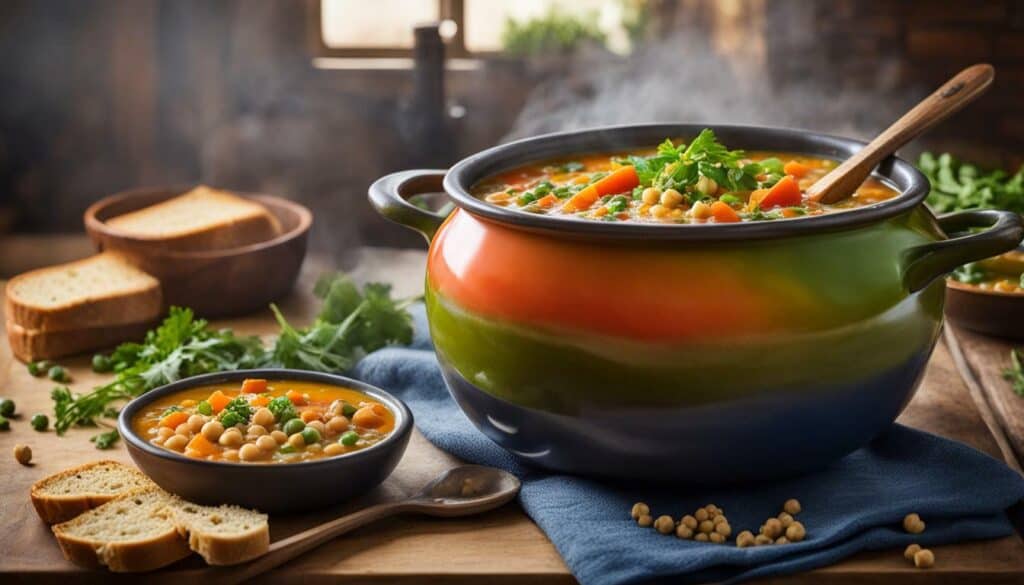
To help you make better choices, here’s a table showcasing the carb content of common soup ingredients:
| Ingredient | Carbohydrate Content (per 100g) |
|---|---|
| Potatoes | 17g |
| Pasta | 25g |
| Rice | 28g |
| Beans | 12g |
| Carrots | 9g |
| Tomatoes | 3.9g |
By being mindful of the carb content in soups and opting for healthier alternatives, you can still enjoy a delicious bowl while supporting your dietary goals. Whether you’re following a low-carb diet or simply looking to reduce your carb intake, there are plenty of options available to satisfy your soup cravings without sacrificing flavor.
Understanding Carb Content in Soups
When it comes to soups, it’s important to be aware of the different ingredients that can contribute to the overall carb content. Some soups are naturally higher in carbs due to the inclusion of starchy vegetables, legumes, or grains, while others may have lower carb content with a focus on protein and vegetables. Understanding the carb content in soups can help us make informed choices that align with our dietary goals and preferences.
One way to assess the carb content in soups is by reading the ingredient labels. Look for ingredients like potatoes, corn, peas, or rice, as these can significantly increase the carb content. Additionally, be mindful of any added sugars or sweeteners, as they can also contribute to the overall carb count.
Here is a breakdown of the carb content in common soup ingredients:
| Ingredient | Carb Content per 1 cup (cooked) |
|---|---|
| Potatoes | 37 grams |
| Corn | 31 grams |
| Peas | 21 grams |
| Rice | 45 grams |
By being aware of the carb content in soups, we can make mindful choices that align with our dietary needs. For those following low-carb or keto diets, there are plenty of alternatives available that use low-carb vegetables, lean proteins, and flavorful seasonings to create delicious and satisfying soup options.
Remember, soup can be a nutritious and comforting meal choice, but it’s important to be mindful of the carb content and choose options that fit your dietary preferences and goals.
For those who want to calculate the carb content in their homemade soup recipes, there are online resources available that can help. One such resource is the “Soup Carb Calculator” provided by the Nutrition Society. This handy tool allows you to input the ingredients and quantities used in your recipe to get an estimate of the carb content per serving. It’s a great tool to have on hand when you want to keep track of your carb intake and create soups that align with your dietary goals.
Good Carbs vs. Bad Carbs in Soups
Not all carbs are created equal, and some soups can be a great source of nutritious, good carbs. Understanding the difference between good and bad carbs can help you make informed choices when it comes to incorporating soups into your diet.
Good carbs, also known as complex carbs, are found in whole foods such as vegetables, legumes, and whole grains. These carbs are rich in vitamins, minerals, and dietary fiber, which contribute to better digestion and offer a steady release of energy throughout the day. Good carb sources in soups can include ingredients like quinoa, lentils, sweet potatoes, and whole grain noodles.
On the other hand, bad carbs, or simple carbs, are typically found in processed foods, sugary treats, and refined grains. These carbs are quickly broken down into sugar by the body, leading to a rapid spike in blood sugar levels. Consuming too many bad carbs can contribute to weight gain, energy crashes, and an increased risk of chronic diseases. It’s important to limit the intake of bad carbs, especially in soups that may contain added sugars or refined grains.
When choosing soups, opt for recipes that prioritize good carb sources and limit the use of added sugars or refined grains. Look for soups that incorporate a variety of vegetables, whole grains, and lean proteins. These soups not only provide a delicious and filling meal, but they also contribute to your overall health and well-being.
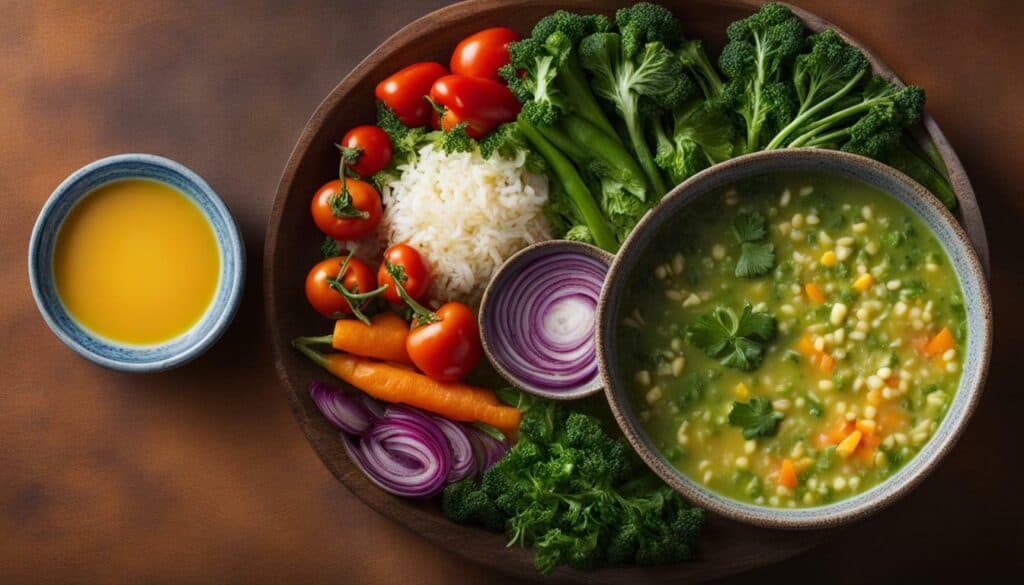
| Good Carb Sources | Bad Carb Sources |
|---|---|
| Vegetables | Sugary Treats |
| Legumes | Refined Grains |
| Whole Grains | Processed Foods |
By understanding the difference between good and bad carbs and making mindful choices when it comes to soups, you can ensure that you’re fueling your body with nutritious and delicious options. So next time you’re craving a warm and comforting bowl of soup, reach for one that is packed with good carbs and wholesome ingredients.
The Role of Fiber in Soup Carbs
Fiber plays a crucial role in soup carbs and can have significant implications for our overall dietary health. When it comes to soups, fiber-rich ingredients like vegetables, legumes, and whole grains can help slow down digestion and promote feelings of fullness, making them an excellent addition to any soup recipe.
Not only does fiber help regulate our digestion, but it also assists in maintaining healthy blood sugar levels. By slowing down the absorption of sugar into the bloodstream, fiber-rich soup carbs can help prevent spikes in blood sugar and provide a sustained release of energy throughout the day. This is especially beneficial for individuals with diabetes or those looking to manage their weight.
In addition to its digestive benefits, fiber has been linked to various health benefits, including reducing the risk of heart disease, supporting gut health, and promoting healthy cholesterol levels. By incorporating fiber-rich ingredients into our soups, we can boost the nutritional value of our meals and support our overall well-being.
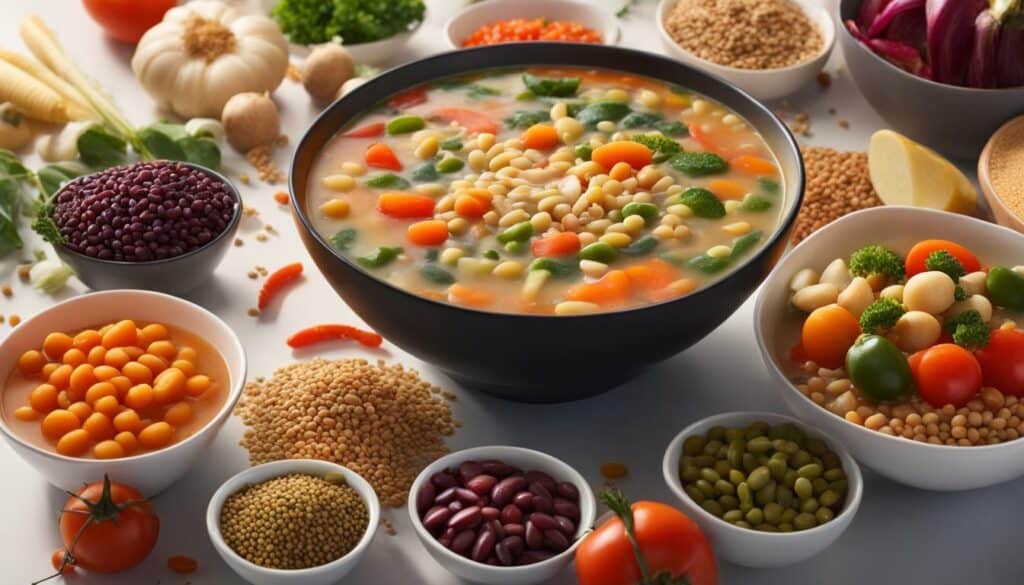
To make it easier for you to incorporate fiber-rich ingredients into your soups, here is a table of some common ingredients and their fiber content:
| Ingredient | Fiber Content (per 100g) |
|---|---|
| Broccoli | 2.6g |
| Spinach | 2.2g |
| Black beans | 7.6g |
| Quinoa | 2.8g |
| Barley | 10.1g |
Adding a variety of fiber-rich ingredients to your soups not only enhances their taste and texture but also provides a range of health benefits. So, next time you’re preparing a delicious bowl of soup, remember to include some fiber-packed ingredients to make it even more nutritious and satisfying!
The Gluten Factor in Soup Carbs
While carbs and gluten are not mutually exclusive, it’s important to be mindful of gluten content when considering soup options. Gluten, a protein found in wheat, barley, and rye, can be present in soups that contain ingredients such as noodles, dumplings, or certain thickening agents. For individuals with gluten sensitivities or intolerances, consuming gluten-containing soups can lead to discomfort and adverse health effects.
Fortunately, there are gluten-free soup options available for those who need to avoid gluten. Many soup manufacturers now offer gluten-free versions of popular soup varieties, making it easier to enjoy a warm and comforting bowl without worrying about gluten content. Additionally, homemade soups can be easily adapted to be gluten-free by substituting gluten-containing ingredients with gluten-free alternatives, such as rice noodles or cornstarch.
It’s important to note that not all individuals need to avoid gluten. For those who do not have gluten sensitivities or intolerances, including gluten-containing soups in their diet can be a nutritious and enjoyable choice. However, for those who need to follow a gluten-free lifestyle, it’s crucial to carefully read ingredient labels and choose soups that are certified gluten-free or made with gluten-free ingredients.
“While carbs and gluten are not mutually exclusive, it’s important to be mindful of gluten content when considering soup options.”
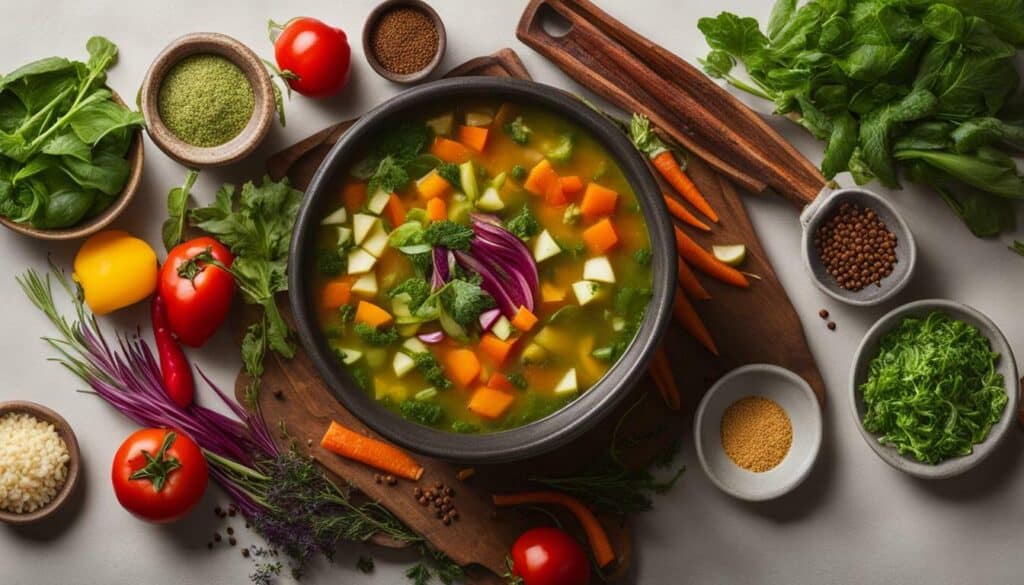
| Soup Type | Gluten Content |
|---|---|
| Chicken Noodle Soup | May contain gluten if made with wheat noodles |
| Tomato Soup | Typically gluten-free |
| Butternut Squash Soup | Typically gluten-free |
| Minestrone Soup | May contain gluten if made with pasta |
Before purchasing or consuming a soup, always check the ingredient list and look for any gluten-containing ingredients. If you are unsure about a specific soup or brand, reach out to the manufacturer for clarification. By being aware of gluten content and making informed choices, you can enjoy a wide variety of delicious soups that align with your dietary needs and preferences.
Healthier Carb Sources in Soups
Incorporating healthier carb sources into soups can provide a wide range of additional nutrients and promote overall health. By choosing nutrient-dense ingredients, you can elevate the nutritional value of your soups while still enjoying delicious flavors. Here are some great options to consider:
- Beans: Beans, such as chickpeas, lentils, and black beans, are excellent sources of carbohydrates, protein, and fiber. They add a hearty texture to soups and provide essential nutrients like iron, folate, and potassium.
- Quinoa: Quinoa is a versatile grain that is high in protein and fiber. It adds a nutty flavor to soups and offers a complete amino acid profile, making it an ideal choice for vegetarian or vegan diets.
- Sweet Potatoes: Sweet potatoes are a nutritious carbohydrate option that adds natural sweetness and vibrant color to soups. They are rich in vitamins A and C, fiber, and antioxidants.
- Whole Grain Pasta: Opting for whole grain pasta instead of refined white pasta in soups boosts the fiber and nutrient content. Whole grain pasta provides sustained energy and helps regulate blood sugar levels.
Remember, variety is key when it comes to incorporating healthier carb sources in soups. Mix and match these ingredients to create flavorful combinations that satisfy your taste buds and provide a well-rounded nutritional profile.
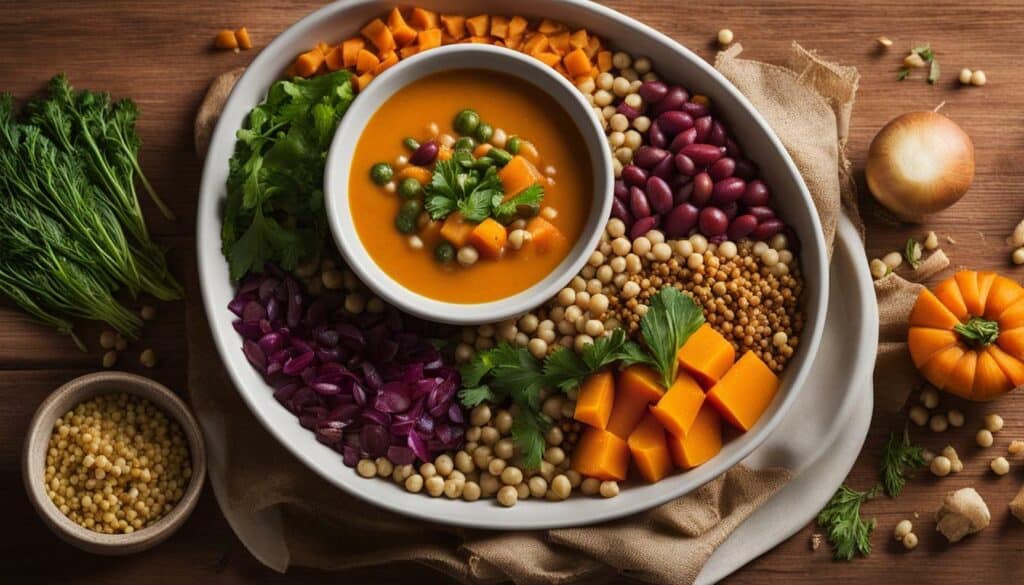
| Ingredient | Carbohydrates per 100g | Fiber per 100g | Protein per 100g |
|---|---|---|---|
| Black Beans | 63g | 16g | 21g |
| Quinoa | 64g | 7g | 14g |
| Sweet Potatoes | 20g | 3g | 2g |
| Whole Grain Pasta | 75g | 6g | 13g |
“Incorporating high-fiber ingredients like beans and quinoa into your soups not only adds a nutritional boost but also helps keep you feeling full and satisfied.”
Experiment with New Flavors
When using healthier carb sources in soups, don’t be afraid to experiment with different flavors and spices. Enhance the taste by adding herbs, spices, and aromatic vegetables like garlic and onions. Additionally, consider using vegetable or chicken broth instead of cream-based broths to reduce the calorie content while still maintaining a rich and flavorful soup base.
By choosing healthier carb sources, you can transform your soups into wholesome and nourishing meals. Whether you’re looking to increase your nutrient intake or simply enjoy a satisfying bowl of soup, these options will add both flavor and nutritional value to your culinary creations.
Tailoring Soup Carbs to Individual Needs
The carb content in soups can be personalized to fit individual dietary needs and preferences. Whether you’re following a carb-conscious diet, managing a specific medical condition, or simply aiming to make healthier food choices, there are several ways to adjust the carb content in your soups.
First, it’s important to choose the right ingredients. Opting for low-carb vegetables like broccoli, cauliflower, zucchini, and spinach can help reduce the overall carb content of your soup while adding valuable nutrients. Additionally, lean protein sources such as chicken, turkey, or tofu can be included to make your soup more satisfying without significantly increasing the carb content.
To further reduce carbs, consider replacing starchy ingredients like potatoes or pasta with alternatives like cauliflower rice or spiralized zucchini. These swaps can help lower the carb count while still providing a similar texture and taste experience.
Another effective way to tailor soup carbs is to control portion sizes. By monitoring the amounts of higher-carb ingredients like legumes or grains, you can easily customize the soup to align with your desired carb intake. It’s also worth considering the use of low-carb thickening agents like almond flour or coconut milk, which can add creaminess and flavor without added carbs.
| Low-Carb Soup Ingredients | Carb Content per Serving (g) |
|---|---|
| Broccoli | 6 |
| Cauliflower | 5 |
| Spinach | 2 |
| Chicken Breast | 0 |
| Tofu | 2 |
| Cauliflower Rice | 5 |
| Zucchini Noodles | 4 |
| Almond Flour | 6 |
| Coconut Milk | 4 |
Remember, tailoring soup carbs to individual needs is all about finding the right balance. It’s essential to consult with a healthcare professional or registered dietitian to determine the appropriate carb intake for your specific dietary goals and medical conditions. By making thoughtful ingredient choices, controlling portion sizes, and experimenting with low-carb alternatives, you can enjoy delicious and satisfying soups that align with your personal preferences.
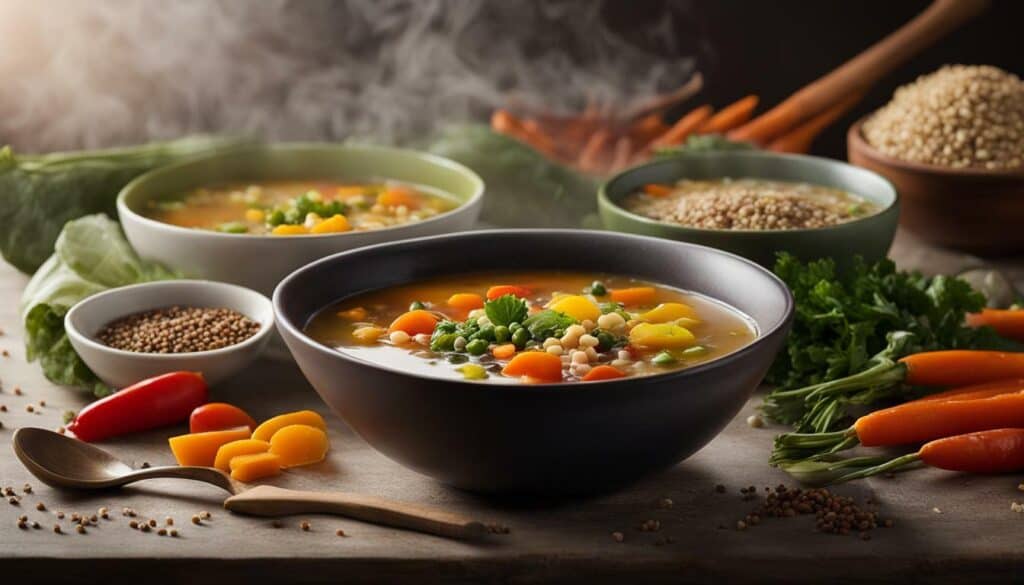
The Recommended Daily Intake of Carbs
The daily intake of carbs should be balanced and based on individual factors to support overall health and well-being. Carbohydrates are an essential macronutrient that provides the body with energy. They can be found in various foods such as grains, vegetables, beans, fruits, dairy, and sweets. It’s important to differentiate between good carbs and bad carbs. Good carbs, also known as complex carbs, are found in whole foods like whole grains, fruits, and vegetables. They contain fiber, vitamins, and minerals that are beneficial for our health.
On the other hand, bad carbs, or simple carbs, are found in processed foods, sugary snacks, and sugary beverages. These carbs are quickly broken down into sugar by our bodies, leading to spikes in blood sugar levels and potentially contributing to weight gain and other health issues. It is recommended to consume mostly good carbs in appropriate portions throughout the day to maintain a balanced diet.
When it comes to determining the daily intake of carbs, there is no one-size-fits-all approach. The amount of carbs needed can vary based on individual factors such as age, sex, activity level, and overall health goals. For example, athletes or those with high physical activity levels may require higher amounts of carbs to fuel their bodies. Conversely, individuals following low-carb diets for weight loss or medical reasons may need to limit their carb intake.
It is worth noting that the concept of net carbs has gained popularity in recent years. It involves subtracting fiber from the total carb count, as fiber is not digestible and does not cause a significant rise in blood sugar levels. This approach can be helpful for those who are conscious of their carb intake and its impact on blood glucose levels.
Understanding the recommended daily intake of carbs is essential for maintaining a healthy and balanced diet. Consulting with a registered dietitian or healthcare professional can provide personalized guidance based on individual needs and goals.
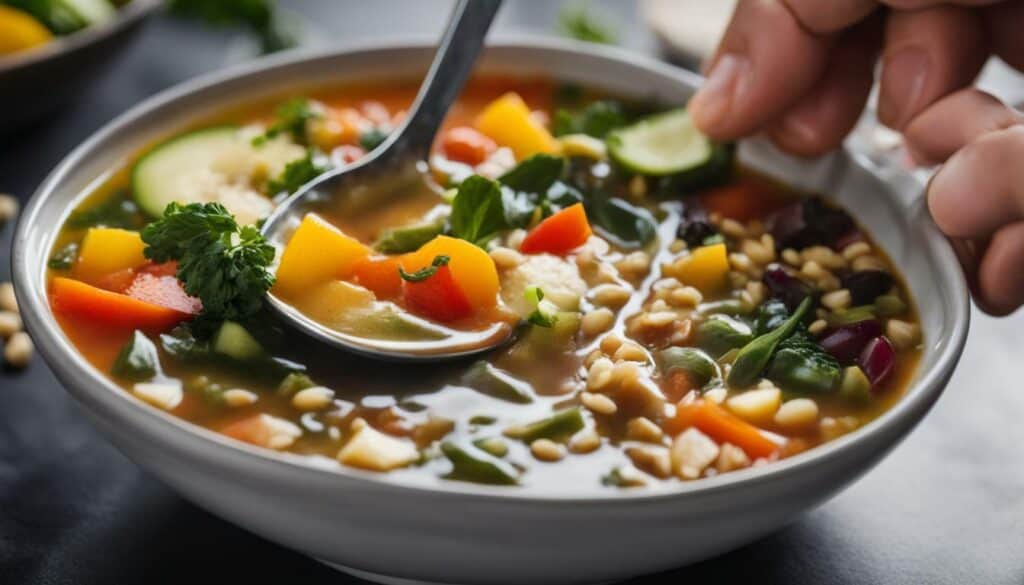
Finding low-carb soup options can be a delicious and satisfying way to reduce carb intake without compromising on taste. Whether you’re following a low-carb diet or simply looking for healthier alternatives, these soups are packed with flavor and nutritious ingredients.
One popular low-carb soup option is a hearty vegetable soup. Loaded with fresh, colorful vegetables and aromatic herbs, this soup is both satisfying and nourishing. It’s a great way to incorporate a variety of low-carb vegetables like broccoli, bell peppers, zucchini, and spinach into your diet. Add a protein source like lean chicken or tofu for a complete and balanced meal.
If you’re craving something warm and comforting, consider a creamy cauliflower soup. Cauliflower is a versatile low-carb vegetable that can be transformed into a rich and creamy base for soups. By substituting heavy cream with unsweetened almond milk or coconut milk, you can keep the soup low in carbs while still achieving a velvety texture. Top it off with some crispy bacon or grated cheese for extra flavor.
Low-Carb Soup Recipes
For those who enjoy a bit of spice, a low-carb chili soup is a perfect choice. Made with ground turkey or beef, tomatoes, and a blend of spices, this soup packs a punch of flavor without the added carbs. Serve it with a dollop of sour cream, sliced avocado, and a sprinkle of chopped cilantro for a satisfying and filling meal.
When it comes to low-carb soups, the options are endless. From classic favorites like chicken noodle soup made with zucchini noodles instead of traditional pasta to a creamy tomato soup with a hint of basil, there’s a low-carb soup recipe to suit every taste and preference.
| Soup Recipe | Carb Content per Serving |
|---|---|
| Hearty Vegetable Soup | 10g |
| Creamy Cauliflower Soup | 8g |
| Low-Carb Chili Soup | 6g |
With these low-carb soup options, you can enjoy a warm and nourishing meal while keeping your carb intake in check. Experiment with different flavors and ingredients to find the soups that best suit your taste buds and dietary goals.

Understanding the carb content in soups is essential for making informed choices about our meals and maintaining a balanced and nutritious diet. While carbs are an important source of energy, it’s crucial to differentiate between good and bad carbs to optimize our overall health.
Good carbs, found in whole foods like fruits, vegetables, and beans, provide essential vitamins, minerals, and fiber. These nutrient-dense options should make up the majority of our carb intake. On the other hand, bad carbs, such as those found in sugary treats and refined grains, offer little nutritional value and can lead to blood sugar spikes and weight gain when consumed in excess.
By prioritizing healthier carb sources in our soups, we can enjoy delicious and satisfying meals without compromising our nutritional goals. Incorporating low-carb soup recipes into our diet can be a great way to reduce carb intake while still enjoying the comfort and flavor of soups.
It’s important to remember that everyone’s carb needs are different. Factors such as age, sex, and activity level play a role in determining the recommended daily intake of carbs. Consulting with a healthcare professional or nutritionist can provide personalized guidance on finding the optimal carb balance for your specific needs.
So next time you reach for a bowl of soup, take a moment to consider the carb content and choose options that align with your dietary goals. By being mindful of soup carbs and making intentional choices, we can nourish our bodies and enjoy the benefits of a well-rounded and carb-conscious diet.
FAQ
Q: What are carbohydrates?
A: Carbohydrates, also known as carbs, are an essential macronutrient that provides energy for the body. They can be found in various foods such as grains, vegetables, beans, fruits, dairy, and sweets.
Q: What is the difference between simple and complex carbs?
A: Simple carbs are quickly broken down into sugar by the body, while complex carbs contain fiber and other nutrients. Complex carbs are generally considered healthier than simple carbs.
Q: What are good carbs and bad carbs?
A: Good carbs refer to whole foods that offer vitamins, minerals, and fiber, while bad carbs include foods with excessive sugar and refined grains.
Q: How many carbs should I consume daily?
A: The daily intake of carbs varies based on individual factors such as age, sex, and activity level. It is recommended to consult a healthcare professional or nutritionist to determine an appropriate carb intake.
Q: Is it effective to go on a low-carb diet for weight loss?
A: Going on a low-carb diet can be effective for weight loss, but it is important to adopt a sustainable approach. It is suggested to consume mostly good carbs in appropriate portions throughout the day.
Q: What are net carbs?
A: The concept of net carbs involves subtracting fiber from total carbs because fiber is not digestible and does not cause a rise in blood sugar. Net carbs provide a more accurate representation of the available carbohydrates in a food item.
Q: Is gluten found only in carbs?
A: No, gluten is a protein found in wheat, barley, and rye, and is not exclusive to carbs. It can be present in various food items, including those that are not carbohydrate-based.
How Many Carbs Does Peppermint Have Compared to Soup?
The carbs content in peppermint discovered is significantly lower compared to soup. While soups can vary widely in their carbohydrate content depending on the ingredients and preparation method, peppermint generally contains very few carbs. So, if you’re looking to reduce your carb intake, opting for peppermint can be a better choice than soup.
Source Links
- https://benedettocambridge.com/know-your-sodium-intake-a-guide-to-olive-gardens-chicken-gnocchi-soup/
- https://www.nbcnews.com/better/health/everything-you-want-know-about-carbohydrates-explained-ncna942211
- https://origin-socialhub.usatodayhss.com/papersCollection/Book?Scribd=Mix-Ohne-Fix-Band-3-Lieblingsgerichte-Aus-Dem-The.pdf

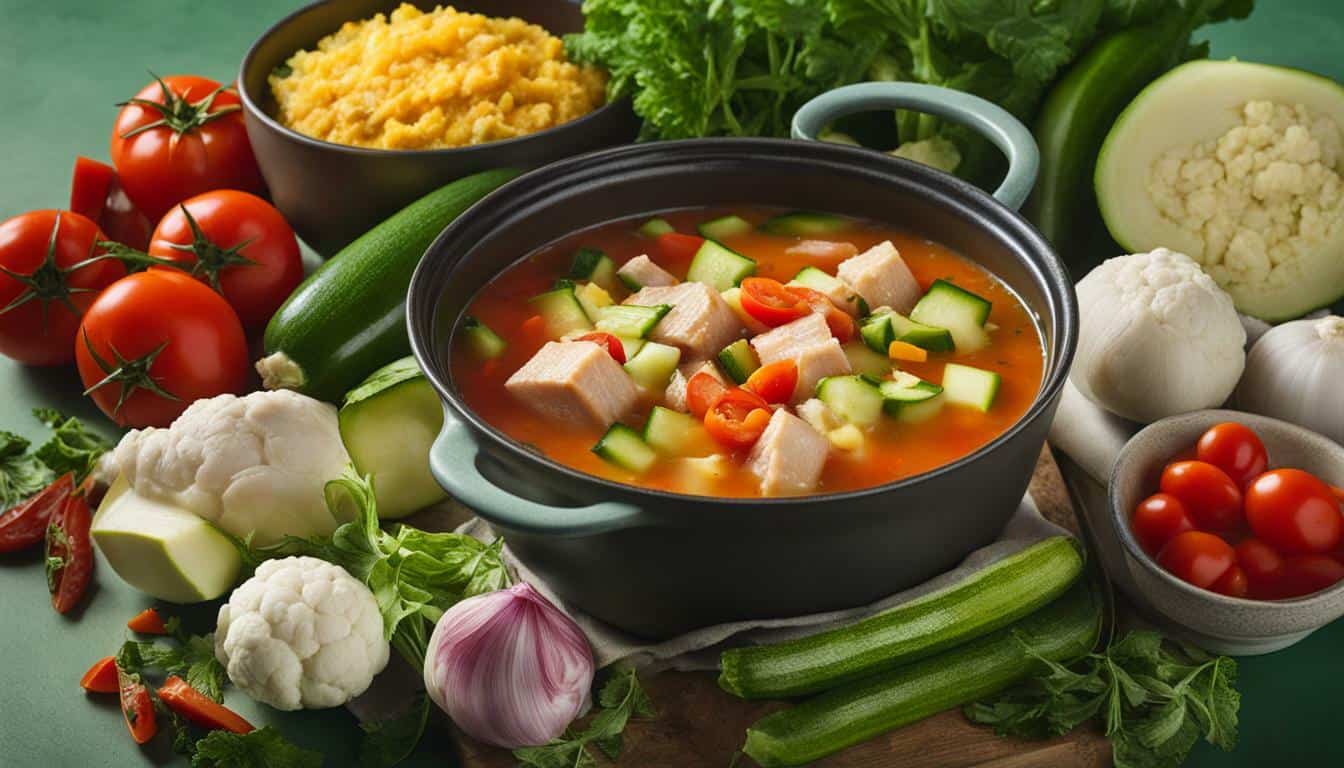



Leave a Reply